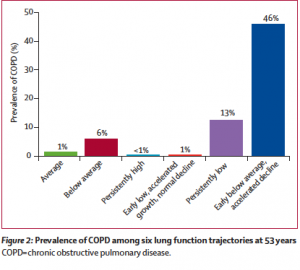Australian research has identified six distinct lung function trajectories from early childhood into the sixth decade – three of which contribute 75% of the disease burden of COPD.
The national study, based on long-term follow-up of 2,438 participants in the Tasmanian Longitudinal Health Study, involved FEV1 measurements at 7, 13, 18, 45 and 54 years of age.
Group-based trajectory modelling identified six patterns of lung function – with the highest prevalence of COPD at 53 years in an early below average, accelerated decline group (46% prevalence of COPD); persistently low group (13%); and below average group (6%). All cases of moderate to severe COPD were found in one of these three trajectories.

“Childhood asthma bronchitis, pneumonia, allergic rhinitis, eczema, parental asthma, and maternal smoking during childhood increased the risk of these three trajectories,” the researchers said.
They also found the impact of childhood risk factors was compounded by smoking and asthma as an adult.
Professor Shyamali Dharmage, from the Allergy and Lung Health Unit at the University of Melbourne, told the limbic one of the novel lung function trajectories identified – early low, accelerated growth then normal decline – showed some early life disadvantage could be overcome.
“We definitely saw a group who caught up after having low lung function in the early years and they were the people who gained weight from age 7 to 14 – they were underweight and gained weight and then they caught up. So that is not surprising because the size of the lungs is determined by your body size.”
Their findings were supported by data from the Perth Infant Asthma Follow-up (PIAF) study, she said.
“And they showed in the infants with low lung function, 75% of them cross-over to good lung function by the time they reach teenage years so there is something that we must be able to do to optimise these lung function trajectories.”
Professor Dharmage said their persistently low lung function trajectory was characterised by asthma, eczema and parental asthma and a borderline association with food allergy.
“These findings suggest that arresting the atopic march, believed to drive these early allergic comorbidities, might help to prevent subsequent adverse lung function and COPD.”
While work to find interventions into lung function trajectory was in its infancy, it included the introduction of food to prevent food allergy, trials of moisturising in infants to prevent eczema and the role of vitamin D in food allergy and subsequently asthma.
“It’s mainly the asthma and smoking that we saw as having an impact on these adverse lung function trajectories over time. But if you can prevent childhood allergies and therefore asthma, then that could be a great thing.”
Professor Dharmage said she hoped the data would also help de-stigmatise COPD, as it was clear that smoking was not the only cause of the disease.
She added they would like to do another follow-up with participants in 5 to 10 years – at an age when COPD rates could be expected to climb.